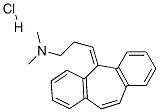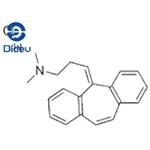Description
Cyclobenzaprine is a skeletal muscle relaxant that also has sedative properties. It has been shown to antagonize muscarinic receptors (K
is = 25, 60, and 6 nM for M
1, M
2, and M
3, respectively), serotonin 5-
HT
2 receptors (K
is = 56 and 330 nM for 5-
HT
2C and 5-
HT
2B, respectively), and histamine H
1 receptor (IC
50 = 20 nM).
Chemical Properties
Crystalline Solid
Originator
Flexeril,Merck Sharp andDohme,US,1977
Uses
Cyclobenzaprine hydrochloride has been used to study its effect on the muscles of dystrophin-deficient mdx5Cv mice.
Uses
Cyclobenzaprine hydrochloride can be used as a serotonin receptor inhibitor.
Uses
Cyclobenzaprine hydrochloride cam be used as muscle relaxant (skeletal).
Definition
ChEBI: The hydrochloride salt of cyclobenzaprine. A centrally acting skeletal muscle relaxant, it is used in the symptomatic treatment of painful muscle spasm.
Manufacturing Process
In an initial step, dibenzo [a,d]cyclohepten-5-one is reacted with the Grignardreagent of 3-dimethylaminopropyl chloride and hydrolyzed to give 5-(3-dimethylaminopropyl)-dibenzo[a,d][1,4]cycloheptatriene-5-ol. Then 13 g ofthat material, 40 ml of hydrochloric acid, and 135 ml of glacial acetic acid isrefluxed for 3? hours. The solution is then evaporated to dryness in vacuoand added to ice water which is then rendered basic by addition of ammoniumhydroxide solution. Extraction of the basic solution with chloroform andremoval of the solvent from the dried chloroform extracts yields the crudeproduct which when distilled in vacuo yields essentially pure 5-(3-dimethylaminopropylidene)-dibenzo[a,d][1,4]cycloheptatriene, BP 173°C to177°C at 1.0 mm.
brand name
Flexeril
(McNeil).
Therapeutic Function
Muscle relaxant
General Description
Cyclobenzaprine is a tricyclic agent, which has anti-depressant and anti-cholinergic properties. It lowers the tonic somatic motor activity of motor neuron systems. Cyclobenzaprine prevents the uptake of?noradrenaline. It is used to treat neck,?back and myofascial pain. Cyclobenzaprine functions as a nerve impulse inhibitor.
References
[1]. honda m, nishida t, ono h. tricyclic analogs cyclobenzaprine, amitriptyline and cyproheptadine inhibit the spinal reflex transmission through 5-ht2 receptors. european journal of pharmacology, 2003, 458(1): 91-99.
[2]. barnes c d, fung s j, gintautas j. brainstem noradrenergic system depression by cyclobenzaprine. neuropharmacology, 1980, 19(2): 221-224.
[3]. leysen j e. 5-ht2 receptors. current drug targets-cns & neurological disorders, 2004, 3(1): 11-26.




